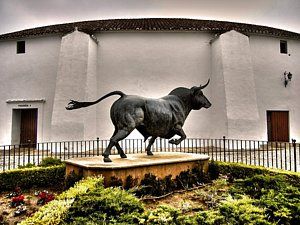Ernest Hemingway pisał o niej, że jest „żywą kulisą teatralną”. To miasteczko to prawdziwa fantasmagoria, teatr absurdu i fantazji. Pięknie usnuta z wizygockiej, arabskiej i hiszpańskiej historii. Miasto przedarte na pół, wąwozem, którego zieleniejące się klify porastają soczystą roślinnością, jak fiordy. Wąwóz ten nazywa się Tajo de Ronda . Po dnie wąwozu płynie wąska rzeka Guadalevín .[ Ernest Hemingway wrote about her that she is a “live theater”. This town is a really phantasmagoria, a theater of absurdity and fantasy. Beautifully done with Visigothic, Arabic and Spanish history. The city is ripped in half, a ravine whose greening cliffs are covered with lush vegetation, like fjords.The gorge is called Tajo de Ronda. The narrow Guadalevín River flows along the bottom of the ravine.]

W Rondzie najslawniejszym mostem jest Puente Nuevo [ In Ronda The most famous bridge is Puente Nevo.]

Rozdziela Ronde na dwie czesci : starsza , mauretańska część miasta (La Ciudad) , oraz późniejsza, chrześcijańska część starówki (El Mercadillo). [Separates Ronde into two parts: the older, Moorish part of the city (La Ciudad), and the later, Christian part of the old town (El Mercadillo).]
Oprócz pięknych zabytków Rondy , można jeszcze poznać piękną historię korridy , gdyż powstała ona dokładnie w tym miejscu . W chrześcijańskiej dzielnicy Rondy – Mercadillo – znajduje się najsłynniejsza obok Puente Nuevo budowla miasta – arena walk byków Real Maestranza de Caballería. To jedna z najstarszych i najznakomitszych “plaza de toros” na terytorium Hiszpanii. To szczególne miejsce dla historyków oraz miłośników korridy. To właśnie tam powstały współczesne zasady tego widowiska obowiązujące do dnia dzisiejszego. Ciekawostką jest że nowa bajka , Fernando – młody byczek była kręcona właśnie w Rondzie [In addition to the beautiful monuments of Ronda, you can still get to know the beautiful history of the Korrida, because it was created exactly in this place. In the Christian district of Ronda – Mercadillo – there is the city’s most famous building near Puente Nuevo – the bullring Real Maestranza de Caballería. It is one of the oldest and finest “plaza de toros” in Spain.This is a special place for historians and lovers of the Korrida. This is where the contemporary principles of this spectacle were in force until today. An interesting fact is that the new fairy tale, Fernando – a young bull was shot in Ronda.]


Jeżeli ktoś nie ma opcji zobaczenia torreadorów w akcji ( gdyż spektakle są tylko w wyznaczonych miesiącach ) , muszą obowiązkowo zobaczyć muzeum- Museo Taurino . Jego zbiory oprócz zapoznania zwiedzających z tajnikami korridy koncentrują się na przedstawieniu dziedzictwa dwóch legendarnych dynastii miejscowych toreros: rodzin Romero i Ordóñez. Pedro Romero ,zasłynął jako pogromca 5.600 byków, który odszedł na emeryturę nie doznawszy nigdy nawet drobnych obrażeń ciała. Na początku września w Rondzie odbywa się wielka fiesta Feria de Pedro Romero podczas której ma miejsce seria pokazowych walk oraz konkursów tzw. Corridas Goyescas. [If someone does not have the option to see the bullfighters in action (because the performances are only in the designated months), they must visit the Museum – Museo Taurino. His collection, in addition to acquainting visitors with the secrets of the Korriga, focuses on presenting the heritage of the two legendary local dynasties of the toreros: the Romero and Ordóñez families. Pedro Romero, became famous as the tamer of 5,600 bulls, who retired without having ever suffered minor injuries. At the beginning of September in Ronda a great fiesta of Feria de Pedro Romero takes place, during which a series of demonstration fights and competitions called so-called. Corridas Goyescas.]


